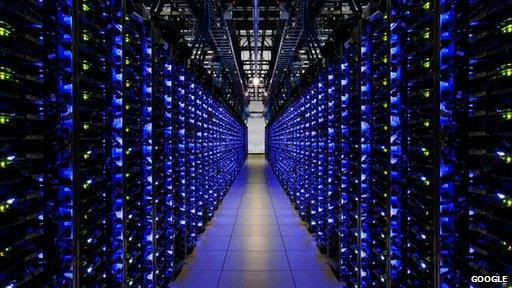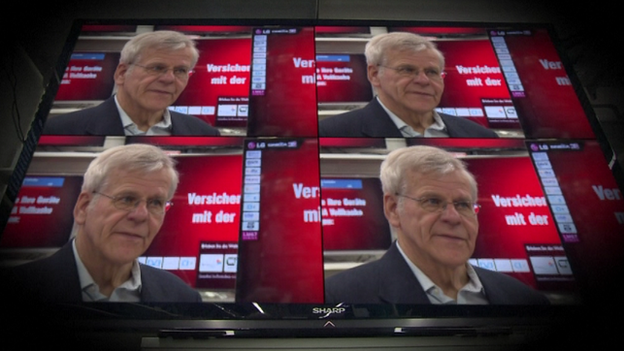Hard disk pioneer Stuart Parkin wins Millennium Prize
- Published

Prof Parkin took advantage of electrons' spin to make cheap storage possible
A British scientist whose work made it possible for hard disks to radically expand in size has been awarded the Millennium Technology Prize.
Prof Stuart Parkin developed a type of data-reading head capable of detecting weaker and smaller signals than had previously been possible.
The innovation allowed more information to be stored on each disk platter.
The foundation behind the award said he had made Facebook, Google, Amazon and other online services possible.
"Parkin is a leading innovator in the field of spintronics, which relies on the magnetic spin of electrons rather than their charge to store bits and is one of the most successful fields of nanotechnology yet," said Technology Academy Finland.
"[His] innovations have led to a huge expansion of data acquisition and storage capacities, which in turn have underpinned the evolution of large data centres and cloud services, social networks, music and film distribution online."
Previous winners of the one million euro ($1.38m; £824,000) award - which is announced every other year - include web inventor Tim Berners-Lee and the Linux operating system kernel developer Linus Torvalds.
Those selected are judged to have invented something that either has changed or has the power to change people's lives for the better, ideally on a global scale.
Sensitive detector
Prof Parkin's field of expertise is a branch of physics called spintronics - or spin electronics.
In this case, the word "spin" refers to a quantum mechanical property of an electron that can be likened to a planet turning around its axis.

The professor says hard disks are able to store roughly 1,000 times more than they would have been without the use of spintronics
Just as planets can rotate clockwise or anti-clockwise, electrons are said to be able to spin up or down - an action that sets up a magnetic field.
The analogy is not perfect, but in short the phenomenon can be exploited to store bits of data on atomically-thin magnetic structures.
Prof Parkin made this possible by building on the observations of two Nobel Prize winners - Albert Fert and Peter Grunberg - to create a highly sensitive detector capable of discerning small magnetic fields at room temperature.
"The spin valve sensing device allowed one to detect much tinier magnetic fields and therefore smaller magnetic regions in a magnetic disk drive," he explained to the BBC.
"The information in a disk drive is basically stored as magnetic regions in a very thin magnetic film.
"So, now we could detect much smaller regions than was possible before, in fact about 1,000 times smaller because of the extreme sensitivity of the spin valve sensing device."

The falling cost of storage has made it affordable to build giant data centres
The work was carried out for IBM, and the firm commercialised the technology in 1997. It soon became an industry standard, allowing disk capacity to quadruple roughly once a year for several years.
That not only made it possible to store more information in computers but also meant it became affordable to build giant data centres.
"The modern world is sustained by our ability to store all our information in magnetic disk drives essentially in the cloud, so that you can instantaneously carry out Google searches, instantly stream music and movies," added Prof Parkin.
"None of those things would be possible without the immense capacities of magnetic disk drives at the very low cost that is possible today... thanks to this spintronic sensing device."
Racetrack memory
The professor continues to work for IBM, and is hoping to spearhead a further storage revolution with an experimental technology he is developing for the firm called Racetrack memory.

Prof Parkin is currently working on a new type of storage codenamed Racetrack memory
The goal is to exploit spintronics to create a new type of storage that would consume less energy than magnetic disk drives but be as high-performing as solid-state flash memory - a more expensive alternative.
"By building a three-dimensional device with tiny nanoscopic wires in which a whole series of magnetic regions are raced to and fro, it can increase the storage capacity of conventional solid-state memory 100-fold," he said.
"It would be as fast and reliable as conventional solid state memories but would be as cheap and capacious as a magnetic disk drive - basically containing the best of both worlds."
While the professor is keen to highlight how his work has made it possible for the internet to offer vast amounts of information and entertainment, he acknowledges that the technology has also been used for more controversial purposes - including the storage and analysis of large amounts of information about the public by cyber-spy agencies.
Even so, he said he had few regrets.
"Of course it's a concern if people misuse data if they can," he said.
"It's like any scientific discovery or development - it can be used for good and sometimes used for bad.
"In my mind the goodness certainly outweighs any downside. The discoveries that can be made possible and the knowledge that can be gained by having access to the information certainly outweigh any negatives in my mind."
- Published29 May 2013

- Published13 June 2012

- Published8 March 2012
